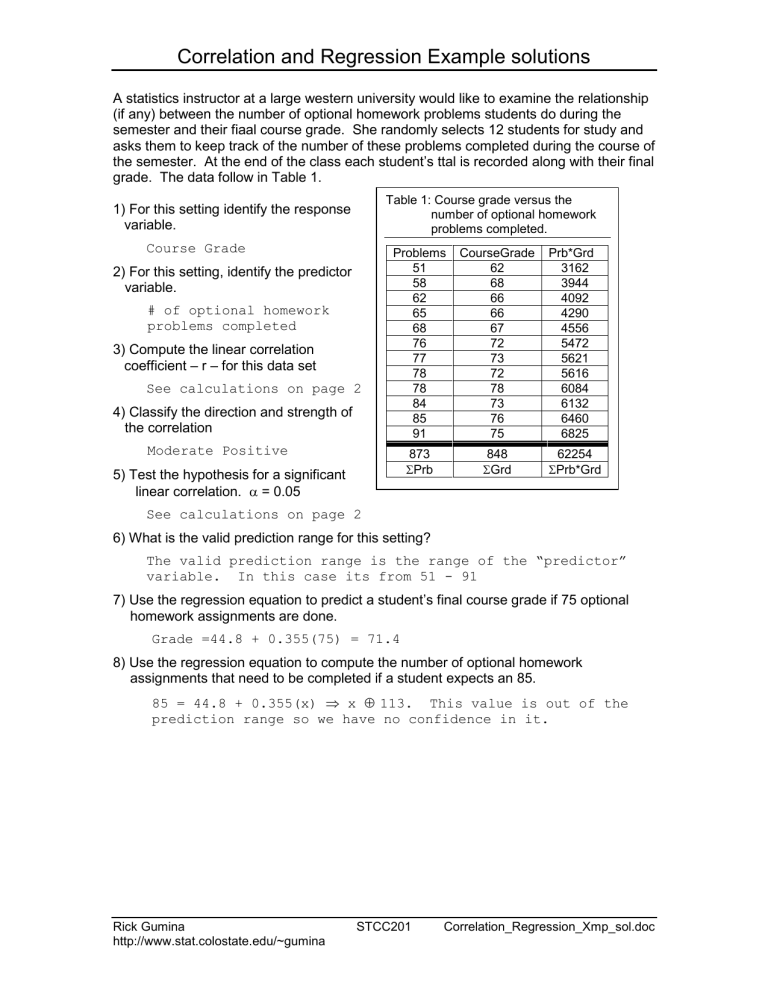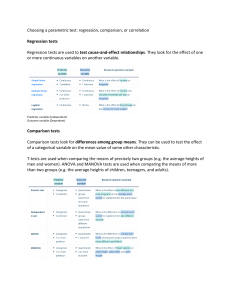
Correlation and Regression Example solutions A statistics instructor at a large western university would like to examine the relationship (if any) between the number of optional homework problems students do during the semester and their fiaal course grade. She randomly selects 12 students for study and asks them to keep track of the number of these problems completed during the course of the semester. At the end of the class each student’s ttal is recorded along with their final grade. The data follow in Table 1. Table 1: Course grade versus the number of optional homework problems completed. 1) For this setting identify the response variable. Course Grade 2) For this setting, identify the predictor variable. # of optional homework problems completed 3) Compute the linear correlation coefficient – r – for this data set See calculations on page 2 4) Classify the direction and strength of the correlation Problems 51 58 62 65 68 76 77 78 78 84 85 91 CourseGrade 62 68 66 66 67 72 73 72 78 73 76 75 873 ΣPrb 848 ΣGrd Moderate Positive 5) Test the hypothesis for a significant linear correlation. α = 0.05 Prb*Grd 3162 3944 4092 4290 4556 5472 5621 5616 6084 6132 6460 6825 62254 ΣPrb*Grd See calculations on page 2 6) What is the valid prediction range for this setting? The valid prediction range is the range of the “predictor” variable. In this case its from 51 - 91 7) Use the regression equation to predict a student’s final course grade if 75 optional homework assignments are done. Grade =44.8 + 0.355(75) = 71.4 8) Use the regression equation to compute the number of optional homework assignments that need to be completed if a student expects an 85. 85 = 44.8 + 0.355(x) ⇒ x ≈ 113. This value is out of the prediction range so we have no confidence in it. Rick Gumina http://www.stat.colostate.edu/~gumina STCC201 Correlation_Regression_Xmp_sol.doc Correlation and Regression Example solutions 3) Calculations for problem 3 r= = n Σ(xy ) − Σx ⋅ Σy n (n − 1)s x sy 12(62254 ) − (873 )(848 ) 12(11)(11.99 )(4.81) = 0.885 5) Hypothesis test for significant linear correlation A) Ho: ρ = 0 Ha: ρ ≠ 0 B) α = 0.05; df = 10; tcrit = ± 2.228 C) t calc = = r 1− r 2 n−2 0.885 1 − (0.885 ) 10 = 6.01 2 D) The decision graphic E) Reject Ho F) At a significance level of 0.05 we can conclude that there is a significant linear correlation between the number of homework assignments and a student’s final grade. Furthermore, we can conclude that this correlation is + Rick Gumina http://www.stat.colostate.edu/~gumina STCC201 Correlation_Regression_Xmp_sol.doc Correlation and Regression Example solutions Output 1: Descriptive statistics for the grade versus homework study Descriptive Statistics: Problems, CourseGrade Variable Problems CourseGr N 12 12 Mean 72.75 70.67 Median 76.50 72.00 TrMean 73.10 70.80 Variable Problems CourseGr Minimum 51.00 62.00 Maximum 91.00 78.00 Q1 62.75 66.25 Q3 82.50 74.50 StDev 11.99 4.81 SE Mean 3.46 1.39 Output 2: Regression output for the grade versus homework study Regression Analysis: CourseGrade versus Problems The regression equation is CourseGrade = 44.8 + 0.355 Problems Predictor Constant Problems S = 2.346 Coef 44.827 0.35519 SE Coef 4.344 0.05898 R-Sq = 78.4% T 10.32 6.02 P 0.000 0.000 R-Sq(adj) = 76.2% Figure 1: Regression plot for the grade versus homework study Rick Gumina http://www.stat.colostate.edu/~gumina STCC201 Correlation_Regression_Xmp_sol.doc




